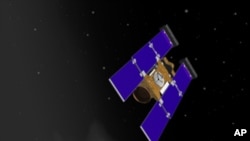Ever run into an old flame a few years after you last saw one another and think that he or she looks pretty different, maybe that time or sun exposure have taken their toll? Now, for the first time, scientists are planning to follow up with a different body -- a comet -- to see how its looks have changed over the years.
Mission objective
NASA's Stardust-NExT spacecraft has a date with a comet called Tempel 1 on the night of February 14th, which happens to be Valentine's Day. During that rendezvous, with only 200 kilometers between them, the Stardust craft will snap 72 high-resolution pictures of Tempel 1.
And this is one comet that is used to being in front of the camera. A NASA mission called "Deep Impact" took photographs of Tempel 1 about six years ago. That is the equivalent of one year in the life of Tempel 1.
Close-up view
Joe Veverka, the principal investigator of the Stardust-NExT mission, told reporters at a NASA briefing Wednesday, that this will be the first opportunity to see how a comet changes between two close passages to the sun.
"We know that comets lose material, but the question is, 'how much does the surface change and where does the surface change?' So we'll be able to answer that question by comparing our images with those taken by Deep Impact in 2005," Veverka said.
During the Deep Impact mission, scientists actually crashed a probe into Tempel 1 and gathered the material it kicked up in order to study the comet's composition.
Snapshot
Scientists said Wednesday that it will be a bonus if the Stardust spacecraft is able to capture an image of the crater created in that crash.
NASA says it is important to study comets because astronomers theorize they are part of a collection of gas, ice, rocks and dust that formed the outer planets of our solar system about 4.5 billion years ago.
Steve Chesley, a Stardust-NExT co-investigator, made it sound a bit sexier.
"Comets are not just inert, simple objects floating out in space. They're dynamic. They're active. They're much more like a rocket with no one at the controls than something that's just idling there," he said.
Sounds like a hot Valentine's date.
Useful data
Tempel 1's orbit brings it as close to the sun as the orbit of the planet Mars, and as far from the sun as the orbit of the planet Jupiter. NASA says data from this upcoming mission could help explain the way the Jupiter-family comets formed.
And this mission is expected to be the grand finale for the Stardust spacecraft, which was part of a mission in 2004 that collected particles directly from yet another comet.
The Stardust craft has been in space since 1999, and it is nearly out of fuel after traveling about 6 billion kilometers.
Stardust Spacecraft, Comet Aiming for Valentine's Day Rendezvous







